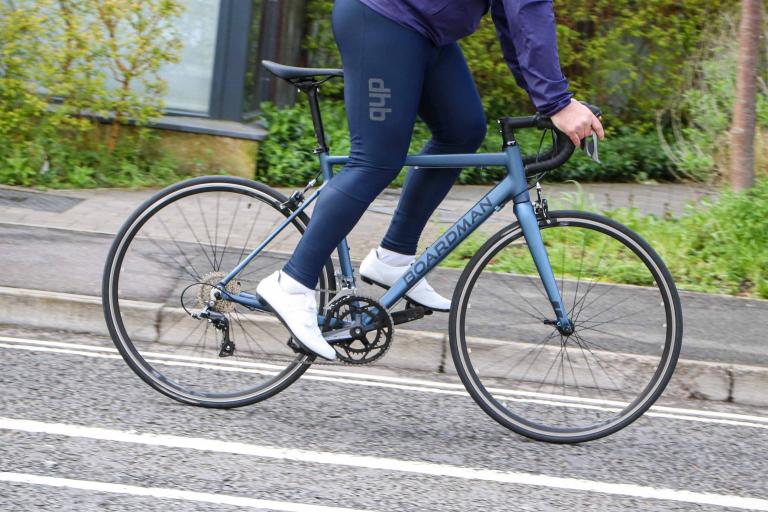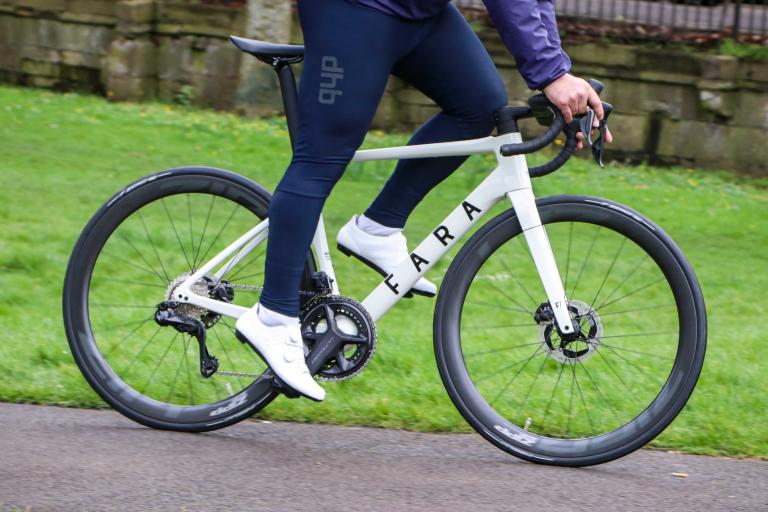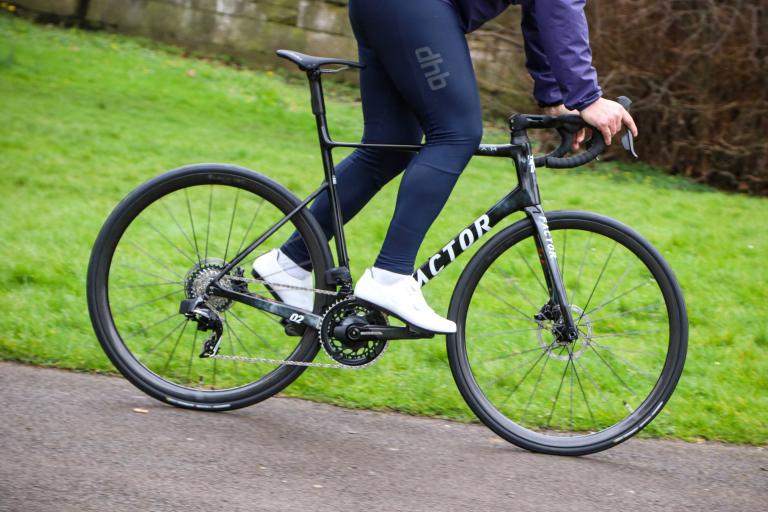- News
- Reviews
- Bikes
- Accessories
- Accessories - misc
- Computer mounts
- Bags
- Bar ends
- Bike bags & cases
- Bottle cages
- Bottles
- Cameras
- Car racks
- Child seats
- Computers
- Glasses
- GPS units
- Helmets
- Lights - front
- Lights - rear
- Lights - sets
- Locks
- Mirrors
- Mudguards
- Racks
- Pumps & CO2 inflators
- Puncture kits
- Reflectives
- Smart watches
- Stands and racks
- Trailers
- Clothing
- Components
- Bar tape & grips
- Bottom brackets
- Brake & gear cables
- Brake & STI levers
- Brake pads & spares
- Brakes
- Cassettes & freewheels
- Chains
- Chainsets & chainrings
- Derailleurs - front
- Derailleurs - rear
- Forks
- Gear levers & shifters
- Groupsets
- Handlebars & extensions
- Headsets
- Hubs
- Inner tubes
- Pedals
- Quick releases & skewers
- Saddles
- Seatposts
- Stems
- Wheels
- Tyres
- Health, fitness and nutrition
- Tools and workshop
- Miscellaneous
- Buyers Guides
- Features
- Forum
- Recommends
- Podcast
review
£3,999.99
VERDICT:
A very good bike bordering on the exceptional, the SL version might just cross that border
Weight:
6,700g
Contact:
www.merida.com
At road.cc every product is thoroughly tested for as long as it takes to get a proper insight into how well it works. Our reviewers are experienced cyclists that we trust to be objective. While we strive to ensure that opinions expressed are backed up by facts, reviews are by their nature an informed opinion, not a definitive verdict. We don't intentionally try to break anything (except locks) but we do try to look for weak points in any design. The overall score is not just an average of the other scores: it reflects both a product's function and value – with value determined by how a product compares with items of similar spec, quality, and price.
What the road.cc scores meanGood scores are more common than bad, because fortunately good products are more common than bad.
- Exceptional
- Excellent
- Very Good
- Good
- Quite good
- Average
- Not so good
- Poor
- Bad
- Appalling
Merida is best known for its mountain bikes, especially thanks to the Multivan Merida cross-country team which boasts the all-conquering Gunn-Rita Dahle Flesja on its roster. But the Taiwanese brand makes a huge range of bikes right across the spectrum: hybrids, cyclo-cross, triathlon, fitness… and we’ve been getting the miles in aboard their top level road race bike, the all-carbon Scultura Evo Team.
First impressions…
The Scultura – which translates as ‘Sculpture’, though we think it sounds more like the name of one of Superman’s enemies – is built around a compact carbon fibre frame that features really chunky main tubes. The bulbous head tube morphs smoothly into a triangular top tube that’s so broad you could eat your dinner off it. Well, kind of. It’s about 50mm wide up front, so it would be okay if you were having sausages.
Anyway… The down tube is almost as wide and even deeper while down south you get a whopping block of carbon around the skeleton bottom bracket shell – which comes complete with little CNC milled windows. They look cool but we can’t help feeling they’re going to be a pain to keep gunk-free. Out back you get a wishbone seatstay and elaborately sculpted chainstays while up front Merida’s full-carbon fork flows tidily into the frame.
Unlike most frames, the Scultura’s doesn’t have a cosmetic surface layer to the carbon – so ours had quite a patchy rather than a regular appearance. It is the fashions at the moment for top-end bikes, (see also the Cervelo P4) it didn’t bother us in the slightest but you might prefer a tiny amount of extra weight in order to get a prettier finish.
It’s built up with SRAM’s high end Red groupset components and spins on Mavic R-SYS wheels…

What’s it like to ride?
Merida might not have the prestige of Storck or Cervélo, say, but make no mistake, this is an excellent bike built around a high-quality frameset.
The Scultura is a real lightweight. It’s not quite as feathery as the Cervélo R3 SL that we tested a few weeks ago but, at 6.7kg (14.7lb) for our 56cm version without pedals, it’s not far off – you’d do well to notice the couple of hundred grams difference. It still hovers just around the UCI’s minimum weight limit (6.8kg/14.96lb) for racing.
You know that, unless the engineers have done something crazy, that’s going to translate into super-quick acceleration… and it does. Jumping on to the Merida after riding something even just a few pounds heavier is a joy. You put the power in, and the response is lightning fast. There’s no wallowing about, very little sideways flex at the bottom bracket, just a direct dose of speed.
It’s a similar tale on the climbs – whether you’re seated or standing, the Merida just doesn’t hang about. Crank it up and it skips towards the summit without a care; it’s one of those bikes that feels like it’s working with you rather than against you on the hills, giving you an extra shove upwards with every pedal stroke. You’ve got no excuses if you don’t get to the top first. Sorry.
The wheels help here. We really rate the R-Syses (is that the plural for R-Sys?) which are light and extremely stiff. There’s no discernible sideways movement of the rims when you get aggressive. Put them as close as you like to the brake blocks and they never rub, even when you’re churning uphill out of the saddle. We’ve done thousands of miles on several sets now and the tubular carbon spokes have always held them super-tight with virtually no maintenance issues.
Merida make much of the Scultura’s FlexStays – wide and flattened seatstays and chainstays designed to absorb high frequency vibration and improve smoothness. They all say that, though, don’t they?
But the truth is, this is a comfortable ride. Maybe those FlexStays do help. Maybe it’s more down to the amount of seat post extending out the top of the compact frame. And Fizik’s Arione saddle, with just the right amount of flex in the hull and rails, is certainly partly responsible – it’s one of our favourites for comfort at a reasonable weight. Whatever it is, we did a couple of 5hr rides without feeling even slightly battered – no worries on that front at all.
Hit really uneven road surfaces fast and the front end can be a little hard to manage, but that’s the price you pay for the light weight. Shift more of your weight on to the bars and it stays planted. That aside, the Scultura behaves just fine. Merida’s own lightweight forks have reinforcing ribs running across the inside of the blades to provide extra lateral rigidity… or so Merida tell us. We didn’t take a hacksaw to them to check. Combined with the R-Sys wheels, they certainly provide precise steering without any sloppiness. Again, really impressive stuff.
What else do you need to know? SRAM’s Red components work great throughout. We got faultless changes through the short-throw levers, love the performance of the flex-free crankset, and can’t fault the skinny, lightweight brake callipers. All good, though Red does bump up the price massively.
If you’d prefer Campag you’re out of luck because Merida don’t spec it. If you want Shimano you can go for Ultegra SL on the £2,299.99 Evo 907-Com. Two other Shimano-equipped Sculturas are available in the UK too, although they don’t have the same superlight frame.
We’ve got two gripes, both fairly minor. First, we couldn’t get the seat post clamp to hold the saddle rails firmly – though that was probably just down to someone cross-threading the bolt. And second, on a bike that’s carbon pretty much throughout, why the aluminium stem? Don’t get us wrong, the FSA model works fine. But it’s not carbon, is it?
Verdict
Manufacturers don’t tend to make mistakes with their flagship models – there’s too much riding on it. Lightweight, fast and impressively comfortable, there’s not a lot to argue with here; this is a fabulous high-end road bike. Should you buy it? Maybe. Bear in mind that you can get a bike that’s nearly as good for half the price. The gains get much, much smaller the more you spend. But if you’re after something from the top tier of performance and it has to be SRAM Red for you, this is a hell of a lot cheaper than the Cannondale Synapse that comes in an almost identical build (£5,299). Think of it that way and it starts to look like a credible candidate for your cash.
Mat has been in cycling media since 1996, on titles including BikeRadar, Total Bike, Total Mountain Bike, What Mountain Bike and Mountain Biking UK, and he has been editor of 220 Triathlon and Cycling Plus. Mat has been road.cc technical editor for over a decade, testing bikes, fettling the latest kit, and trying out the most up-to-the-minute clothing. He has won his category in Ironman UK 70.3 and finished on the podium in both marathons he has run. Mat is a Cambridge graduate who did a post-grad in magazine journalism, and he is a winner of the Cycling Media Award for Specialist Online Writer. Now over 50, he's riding road and gravel bikes most days for fun and fitness rather than training for competitions.
Latest Comments
- teckert 1 sec ago
You can see the effect of a 'way too late' opening of this comp, with my dismal results! Wrecked a good start to my season.
- Cycle Happy 44 min 26 sec ago
Then when a car ran into Hirsute he didn't say anything ever again. ...
- IanMunro 57 min 45 sec ago
It was off my list of helmets worth buying as soon as I saw someone had named it "Game Changer".
- mark1a 2 hours 25 min ago
Looks valid to me although on a black Mercedes C Class. Last V5 issued 25th April (2 days ago) so maybe plate was being transferred.
- Sam3 5 hours 49 min ago
Asked for comment, a representative of the biker community said: "We are realigning our expenditure better reflect our strategic priorities and...
- Sam3 5 hours 53 min ago
So highly overpriced items such as "premium bike clothing" and overpriced "premium" bikes that no one NEEDS....suffer a disproportionate...
- chrisonabike 8 hours 4 min ago
Well good for Yate! Looking on Street view the 2021 pictures suggest nothing less than a genuinely "massive" amount of cash * will help. That...
- Blackthorne 9 hours 13 min ago
Well Paddy Murray seems to have been nicely rewarded for his efforts to drive Stages into the ground.






























Add new comment
3 comments
Why spec an alloy stem? Come on Roger you must know that as bike-tester-extraordinare, you use the most appropriate material for a job. The aluminium FSA stem at 99 gram is as light but stiffer that any carbon stem out there
I'd never buy a carbon stem, ever. all a stem has to do is resist twisting forces, and there's nothing better than an aluminium tube for that. I've tried some real dogs of carbon stems in my time, the 2007 EC90 being the worst. I could move the drops on my bars up and down about an inch. AN INCH! Some Alu stems aren't pretty (not a critcism that could be levied on the FSA IMHO) but I've never used one that wasn't up to the job.
Yeah, we had a chat about that in the office hummed and hawed about whether to take it out. Big Dave, in particular, is a fan of a strong aluminium stem.
It's more the fact that on a four grand bike we'd want everything to be shiny and bling too. That's all. We know... bike tarts. But there you go.